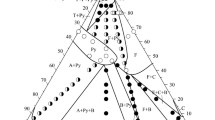Abstract
We report the crystal structures determined under ambient condition for two Zn2SiO4 polymorphs synthesized at 6.5 GPa and 1,273 K (phase III) and 8 GPa and 1,273 K (phase IV) and also compare their 29Si MAS NMR spectroscopic characteristics with those of other Zn2SiO4 polymorphs (phases I, II and V). Electron microprobe analysis revealed that both of phases III and IV are stoichiometric like the lower-pressure polymorphs (phases I and II), contrary to previous report. The crystal structures were solved using an ab initio structure determination technique from synchrotron powder X-ray diffraction data utilizing local structural information from 29Si MAS NMR as constraints and were further refined with the Rietveld technique. Phase III is orthorhombic (Pnma) with a = 10.2897(5), b = 6.6711(3), c = 5.0691(2) Å. It is isostructural with the high-temperature (Zn1.1Li0.6Si0.3)SiO4 phase and may be regarded as a ‘tetrahedral olivine’ type that resembles the ‘octahedral olivine’ structure in the (approximately hexagonally close packed) oxygen arrangement and tetrahedral Si positions, but has Zn in tetrahedral, rather than octahedral coordination. Phase IV is orthorhombic (Pbca) with a = 10.9179(4), b = 9.6728(4), c = 6.1184(2) Å. It also consists of tetrahedrally coordinated Zn and Si and features unique edge-shared Zn2O6 dimers. The volumes per formula under ambient condition for phases III and IV are both somewhat larger than that of the lower-pressure polymorph, phase II, suggesting that the two phases may have undergone structural changes during temperature quench and/or pressure release.





Similar content being viewed by others
References
Baur WH (1980) Solid-solutions between octahedral and tetrahedral olivine types in Li–Zn–germanates. Inorg Nucl Chem Lett 16:525–527
Baur WH, McLarnan TJ (1982) Observed wurtzite derivatives and related dipolar tetrahedral structures. J Solid State Chem 42:300–321
Dent Glasser LS, Glasser FP (1964) The preparation and crystal data of the cadmium silicates CdSiO3, Cd2SiO4 and Cd3SiO5. Inorg Chem 3:1228–1230
Favre-Nicolin V, Černý R (2002) FOX, ‘free objects for crystallography’: a modular approach to ab initio structure determination from powder diffraction. J Appl Cryst 35:734–743
Fujino K, Sasaki S, Takéuchi Y, Sadanaga R (1981) X-ray determination of electron distributions in forsterite, fayalite and tephroite. Acta Cryst B 37:513–518
Ghose S, Boving P, LaChapelle WA, Wan C (1977) Reinerite, Zn3(AsO3)2: an arsenite with a novel type of Zn-tetrahedral double chain. Am Mineral 62:1129–1134
Hang C, Simonov MA, Belov NV (1970) Crystal structures of willemite Zn2[SiO4] and its germanium analog Zn2[GeO4]. Sov Phys Cryst 15:387–390
Izumi F, Ikeda T (2000) A Rietveld-analysis program RIETAN-98 and its applications to zeolites. Mater Sci Forum 321–324:198–205
Izumi F, Momma K (2007) Three-dimensional visualization in powder diffraction. Solid State Phenom 130:15–20
Kanzaki M (1992) Application of the heating curve technique for pressure calibration in a multianvil high-pressure device. High Temp High Press 24:519–523
Kanzaki M, Ito E (1982) High-pressure phase relations of Zn2SiO4 and ZnSiO3 systems. Abst 23rd High Press Conf Japan, 154–155 (in Japanese)
Kanzaki M, Xue X (2012) Structural characterization of moganite-type AlPO4 by NMR and powder X-ray diffraction. Inorg Chem 51:6164–6172
Kanzaki M, Xue X, Reibstein S, Berryman E, Namgung S (2011) Structures of two new high-pressure forms of AlPO4 by X-ray powder diffraction and NMR spectroscopy. Acta Cryst B 67:30–40
Karazhanov SZh, Ravindran P, Vajeeston P, Ulyashin AG, Fjellvåg H, Svensson BG (2009) Phase stability and pressure-induced structural transitions at zero temperature in ZnSiO3 and Zn2SiO4. J Phys Condens Matter, 21. doi:10.1088/0953-8984/21/48/485801
Kirkpatrick RJ (1988) MAS NMR spectroscopy of minerals and glasses. In: Hawthorne FC (ed) Spectroscopic methods in mineralogy and geology, reviews in Mineralogy vol 18. Washington D.C., pp 358–359
Liu L, Bassett WA (1986) Elements, oxides, silicates: high-pressure phases with implications for the earth’s interior. Oxford Press, New York, p 250
Marumo F, Syono Y (1971) The crystal structure of Zn2SiO4-II, a high-pressure phase of willemite. Acta Cryst B 27:1868–1870
Momma K, Izumi F (2011) VESTA 3 for three-dimensional visualization of crystal, volumetric and morphology data. J Appl Cryst 44:1272–1276
Morimoto N, Nakajima Y, Syono Y, Akimoto S, Matsui Y (1975) Crystal structure of pyroxene-type ZnSiO3 and ZnMgSi2O6. Acta Cryst B 31:1041–1049
Nalbandyan V, Novikova A (2012) Structural chemistry of A 2 MX 4 compounds (X = O, F) with isolated tetrahedral anions: search for the densest structure types. Acta Cryst B 68:227–239
Nishibori E, Takata M, Kato K, Sakata M, Kubota Y, Aoyagi S, Kuroiwa Y, Yamakata M, Ikeda N (2001) The large Debye-Scherrer camera installed at SPring-8 BL02B2 for charge density studies. J Phys Chem Solids 62:2095–2098
Ringwood AE, Major A (1967) High pressure transformations in zinc germanates and silicates. Nature 215:1367–1368
Shannon R (1976) Revised effective ionic radii and systematic studies of interatomic distances in halides and chalcogenides. Acta Cryst A 32:751–767
Stebbins JF (1995) Nuclear magnetic resonance spectroscopy of silicates and oxides in geochemistry and geophysics. In: Ahrens TJ (ed) Mineral physics and crystallography, a handbook of physical constants. AGU, Washington, pp 303–331
Syono Y, Akimoto S, Matsui Y (1971) High pressure transformation in zinc silicates. J Solid State Chem 3:369–380
Takesue M, Hayashi H, Smith RL (2009) Thermal and chemical methods for producing zinc silicate (willemite): a review. Prog Cryst Growth Ch Mater 55:98–124
Werner P-E, Eriksson L, Westdahl M (1985) TREOR, a semi-exhaustive trial-and-error powder indexing program for all symmetries. J App Cryst 18:367–370
Xue X, Kanzaki M, Fukui H (2010) Unique crystal chemistry of two polymorphs of topaz-OH: a multi-nuclear NMR and Raman study. Am Mineral 95:1276–1293
Yu S, Smith DK, Austerman SB (1978) The crystal structures and the phase transformation of Zn-Li silicates. Am Mineral 63:1241–1248
Zemann J (1960) Die Kristallstruktur von Lithiumphosphat, Li3PO4. Acta Cryst 13:863–867
Acknowledgments
Synchrotron powder X-ray diffraction patterns were measured at BL19B2 of SPring-8 (Proposal No. 2011B1990). This study was carried out at the Institute for Study of the Earth’s Interior (ISEI), Okayama University and supported by Grants-in-Aid for Scientific Research funded by the Ministry of Education, Culture, Sports, Science and Technology of Japan to M.K. and X.X. We thank Prof. M. Matsui, the editor, and two anonymous reviewers for helpful comments, and Dr. Y. Yachi for assistance with EPMA analysis. X.L. thanks Prof. S. Zhao (China University of Geosciences) for encouragements and the joint-doctoral program of the China Scholarship Council and the collaborative research program of ISEI for financial supports during his stay at ISEI.
Author information
Authors and Affiliations
Corresponding author
Rights and permissions
About this article
Cite this article
Liu, X., Kanzaki, M. & Xue, X. Crystal structures of Zn2SiO4 III and IV synthesized at 6.5–8 GPa and 1,273 K. Phys Chem Minerals 40, 467–478 (2013). https://doi.org/10.1007/s00269-013-0584-6
Received:
Accepted:
Published:
Issue Date:
DOI: https://doi.org/10.1007/s00269-013-0584-6




